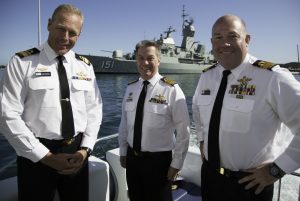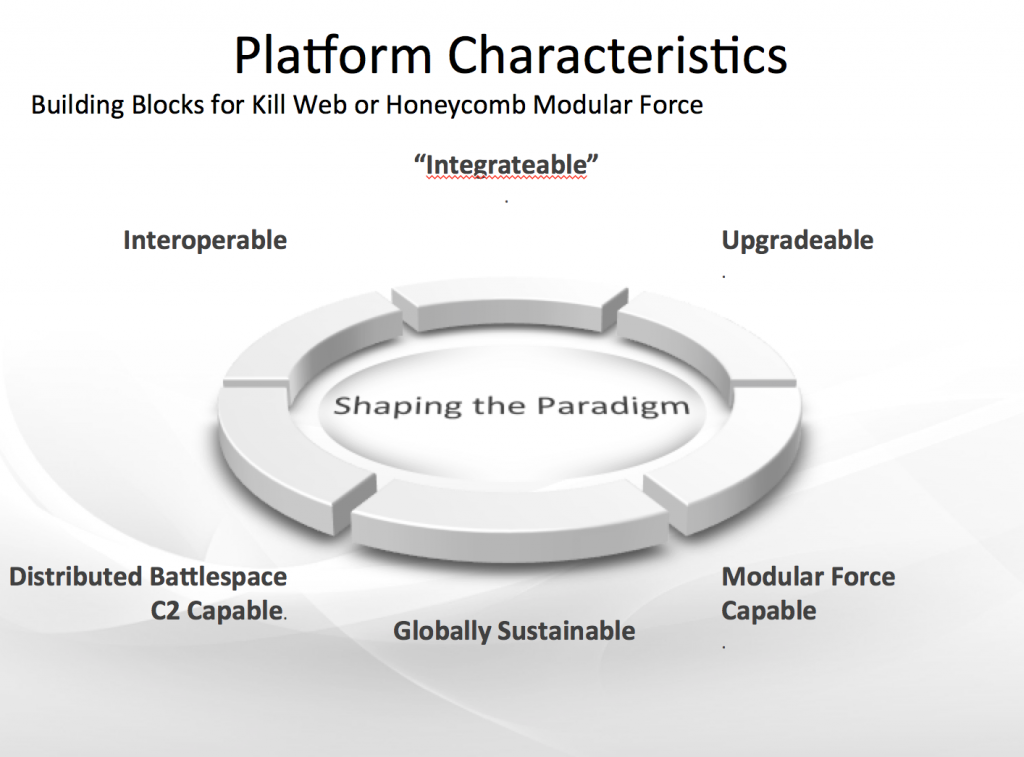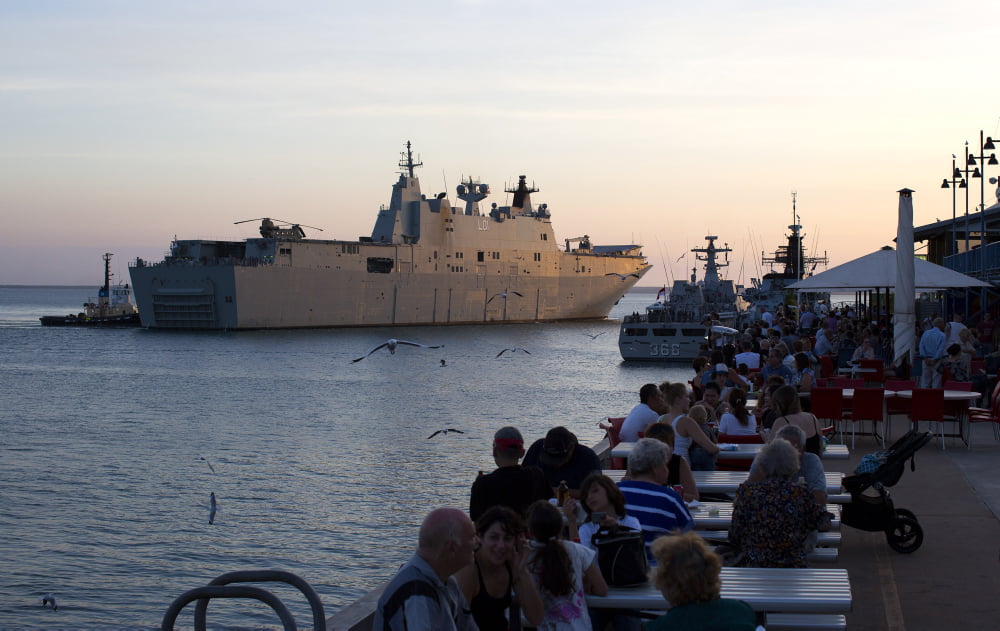2016-11-05 By Robbin Laird
© 2016 FrontLine Defence (Vol 13, No 5)
The Australian Navy is in the throes of its largest recapitalization since the end of World War II – and it’s coming at a time when the Australian Defence Force (ADF) is working across the services to shape an integrated force.
This means that although the Navy will be acquiring new platforms (from the ground up), it is looking closely at the “integrateability” of those new platforms with Army, Air Force, and space capabilities as well.
In August, the Williams Foundation hosted a seminar in Canberra on new approaches to air-sea integration. I had a chance to interview a number of senior Navy, Air Force and Army officers before, during and after the seminar, and these interviews provided a comprehensive picture of how the Australian Navy is modernizing and how its service partners view the cross-modernization efforts among Navy, Army and Air Force.
The Aussies are shaping a transformed military force, one built around new platforms but ones that operate in a joint manner in an extended battlespace.
The goal is to extend the defence perimeter of Australia and create, in effect, their own version of an Anti-Access/Area Denial (A2/AD) strategy.
They also recognize a key reality of 21st century military evolution in terms of shaping an integrated information-based operating force. Interactive modernization of the force is built around decision-making superiority and that will come with an effective information dominant force.

Vice Admiral Tim Barrett, Chief of the Navy, provided a strategic overview on how he saw the way ahead for the Australian Navy. His conference presentation underscored that “we are not building an interoperable navy; we are building an integrated force for the Australian Defence Force.” He drove home the point that ADF integration was crucial in order for the ADF to support government objectives in the region and beyond and to provide for a force capable of decisive lethality.
By so doing, Australia would have a force equally useful in coalition operations in which distributed lethality is the operational objective. He noted that it is not about massing force in a classic sense; it is about shaping a force that can “maximize the adversary’s vulnerabilities while reducing our own.”
Barrett reinforced, several times, that this is not about an ‘add-in, after the fact capability’; instead, he asserted the need to design and train from the ground up, to have a force trained and equipped to be capable of decisive lethality.
He modernized Patton’s great quote, saying that you fight war with technology; but you win with people. It is about equipping the right way with the right equipment, and training effectively to gain a decisive advantage. In this way, he believes the recapitalization effort created “a watershed opportunity for the Australian Navy.”
He sees this opportunity, not so much in terms of simply building new platforms, but the right ones. And with regard to the right ones, he had in mind, ships built from the ground up which could be interoperable with JSF, P-8, Growler, Wedgetail and other joint assets. “We need to achieve the force supremacy inherent in each of these platforms, but we can do that only by shaping integrated ways to operate.”
He highlighted that the Navy is in the process of shaping a 21st century task force concept appropriate to a strategy of distributed lethality and operations.
A key element of the new approach is how platforms will interact with one another in distributed strike and defensive operations, such as the ability to cue weapons across a task force.

After his presentation, I had the chance to sit down with Vice Admiral Barrett and to expand the conversation. Clearly, a key element in his thinking is how to get the new build of ships right for an age in which one wants to build an integrated, but distributed force.
The Vice Admiral underscored that “We need agility in the process of changing ships through life, continuing to evolve the new ships, depending on how the threat is evolving. This means that we need to control the combat system software as well as build the hulls. We will change the combat system and the software many times in the life of that ship; whereas, the hull, machinery in the plant doesn’t.
“That might sound like a statement of the obvious, but it’s not a statement that’s readily understood by our industry here in Australia. We need to organize ourselves to have an effective parent navy capability. We need to manage commonality across the various ship build processes. That will not happen if we build someone else’s ship in Australia which is designed to operate in separate classes.”
He added that Australia needs a holistic approach. “I don’t want an individual class to be considered in isolation. I want to cross-learn and cross-operate throughout our various classes of ships, and notably with regard to software integration and development.”
The shaping a new task force approach as well as the challenge of building out a force capable of integration in the battlespace was underscored by Rear Admiral Stuart Mayer, Commander of the Australian Fleet. He points out that the Army, Navy and Air forces are evolving in the context of tapping shared networks to empower their platforms to form an extended battlespace. But the challenge, he observed, is to work through how to most effectively shape, coordinate and execute effects from the networked force while retaining decision authorities at the lowest practical level to achieve speed of decision.
He highlights that the Navy is returning to a task force concept but one that is 21st century in character, whereby Navy is tapping into ground and air assets as “part” of the task force, rather than simply focusing on Navy-operated assets.
This evolution of the task force effect and the networked approach, clearly in the mode of what the U.S. Navy refers to as the “kill web,” will require the evolution of capabilities, both in terms of connectivity, and training.
During the seminar he characterized the network as a weapon system with “no single master” and that one of the ADF’s challenges is to shape the evolving network in order to effectively operate in a distributed multi domain task force. “Each service is designing its platforms and enabling their potential through the elements of a common network,” he explains.
There is increased overlap for the air and sea forces, at the very least through the access and synergy provided in the network. “A fundamental question presents itself,” he continued, “how should we best develop, certify and deploy our joint network that must be cross domain in nature?”
RAdm Mayer argues that the Australian Defence Force is on a good track but needs to enhance its capability to work in a joint domain that recognizes that tactical effects are generated by Services, while operational outcomes are inherently Joint.
In effect, the Services provide the muscle behind the Joint intent.
If the ADF is to achieve its potential, it will need to design forces from the ground up that are interconnected by a single reference standard rather than simply connecting assets after the fact. But to do so requires an open architecture approach to building a joint network that recognizes the different needs of the participants.
The role of the network as a weapon system requires that it be designed, deployed and certified like any other weapon system.
“We are joint by necessity. Unlike the U.S. Navy, we do not have our own air force or our own army. Joint is not a theological choice, it’s an operational necessity.”
It was clear, both from his presentation and our discussion during an interview, that Rear Admiral Mayer is focused on how the build out of the Navy in the period ahead will be highly correlated with the evolution of the joint network. “The network is a weapons system. Lethality and survivability have to be realized through a networked effect.”
He emphasized throughout the interview that not enough work has yet been done to prioritize the evolving C2 and network systems that empower the platforms in the force, including but not limited to the amphibious force. He sees this area of development as a crucial one in creating a more interactive joint force able to deliver lethal effect.
“The potential of each of the individual platforms in a network is such that we’ve actually got to preset the limits of the fight before we get to it. The decisions on what we’ll do, how much we’ll share, and what sovereign rights we will retain have to be preset into each one of the combat systems before you switch it on and join a network. There is no point designing a combat system capable of defeating supersonic threats and throttling it with a slow network or cumbersome C2 decision architecture.”
The Navy is adding new capabilities with the amphibious ships, the new air warfare destroyer and a new submarine, but inherent in this effort is that the platforms they will build will be highly “integrateable” with Wedgetail, the F-35, the P8 and Triton – all of which are part of the evolving task force concept to operate with flexible and modular forces.
“The nature of the force we are shaping is analogous to a biological system in which the elements flourish based on their natural relationship within the environment. We have an opportunity to shape both the platforms and the network, but we will only achieve the flourishing ecosystem we seek if each harmonize with the other, and the overall effectiveness is considered on the health of the ecosystem overall.”
RAdm Mayer illustrated his point by discussing the evolving anti-submarine warfare approach.
“An ASW network will leverage the potential of the individual constituent platforms and that in turn will determine the lethality of the system. When the individual platforms actually go into a fight, they’re part of an interdependent system. The thing that will dumb down the system will be a network that’s not tailored to leverage the potential of the elements, or a network that holds decision authority at a level that is a constraint on timely decision-making. The network will determine the lethality of our combined system.”
This message meshed with what Rear Admiral Mead had to say from his office in Canberra. The joint capability manager for the Australian navy highlighted how the Navy’s new build of ships is solidly placed in a joint context. For example, with regard to the new submarines, the Navy is looking at its interactive role in the battlespace. “The new submarines and their combat systems will clearly be designed effectively to tap into the maritime warfare network. The task will be moving that information around so it won’t duplicate and so there’s no gaps in the coverage.”
An interview with Rear Admiral Tony Dalton, the head of the Joint Systems Division of the ADF’s acquisition and sustainment group, was next on my agenda.
RAdm Dalton talked of the importance of software upgradeable platforms. We discussed the Wedgetail aircraft, which is evolving from an air battle management system to a battle managements system with Army and Navy officers onboard – working the joint integration piece and evolving the software accordingly.
He went on to explain his perspective of the general evolution of navy platforms in the decade ahead. “The evolving maturation of the Wedgetail radar is bringing new capabilities to the joint force, and we are looking at other systems, such as the new systems on board our surface fleet, to evolve in a similar manner.
The locally developed, phased array radars onboard our Anzac-class frigates are good, but the next generation is on a different planet in terms of capability. It’s driving a change in the way we think. It’s not a classic radar at all; it’s a high power, highly sensitive transmitter and receiver array. You can do lots of things with it in the battlespace.
This is a reforming technology that will reshape the way we think about task groups, how ships communicate, how they operate, and where their blind arcs are.”
In short, the recapitalization of the Australian Navy is about adding new platforms, but with a very different approach than in the past. It is not about replacement platforms focused on narrowly-specialized functions.
It is ships built in the software-upgradeable age and able to cross-modernize with new Air Force and Army systems.
It is about shaping an integrated force that can deliver lethal effect in the defence of Australia when necessary, and work effectively with core allies.
http://defence.frontline.online/article/2016/5/5499-Australia-Shaping-an-Integrated-Force
The slideshow highlights ships involved in Exercise KAKADU 2016, held this past September.
Exercise KAKADU involves nations from around the Asia-Pacific region enhance interoperability, share knowledge and develop skills in responding to threats in the maritime and air domains with a multinational force.
The photos are credited to the Australian Ministry of Defence.


